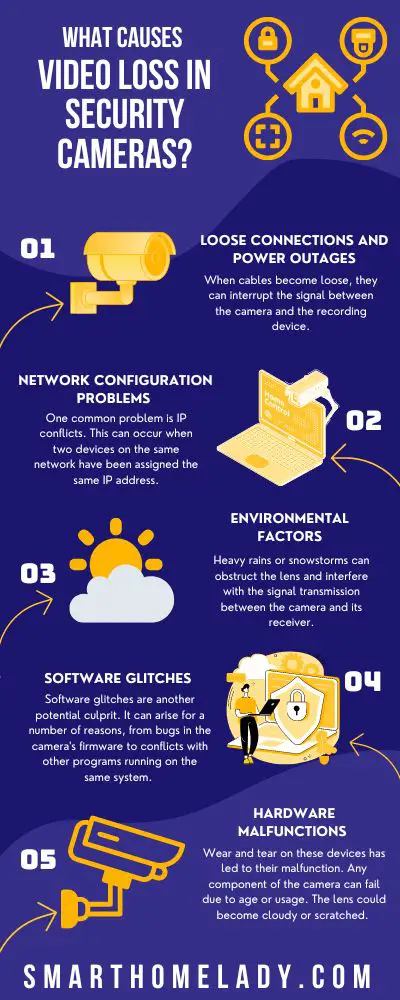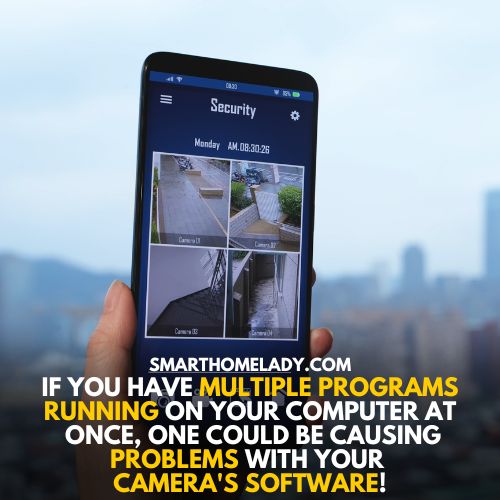In this article, I’ll shed some light on one of the most frustrating issues that every security camera user faces: video loss.
It can be a real pain when you need footage for an investigation or just want to keep tabs on your property, but all you see is a blank screen or a message saying ‘no signal.’
I have personally faced this issue, and it was really frustrating for me. So, what causes video loss in security cameras? Let’s find out.

Contents
- 1 5 Common Causes Of Video Loss In Security Cameras With Solution
- 2 1. Video Loss Due To Loose Connections And Power Outages
- 3 2. Network Configuration Problems Cause Video Loss
- 4 3. Environmental Factors May Cause Video Loss
- 5 4. Software Glitches Cause Video Loss
- 6 5. Hardware Malfunctions Causes Video Loss
- 7 Why does my security camera say video loss?
- 8 What is the main problem for CCTV?
- 9 Do CCTV cameras delete footage?
- 10 How To Fix CCTV Camera Video Loss?
- 11 Why do my Swann cameras say video loss?
- 12 Conclusion
5 Common Causes Of Video Loss In Security Cameras With Solution
In my experience, I’ve seen many cases where users assume that their cameras are faulty or damaged without understanding why they’re not getting any feed.
- Sometimes, it could be as simple as loose connections or power outages affecting the system.
- Other times, more complex factors like network configuration problems or software glitches might be at play.
Whatever the case may be, let’s explore some common culprits behind video loss in security cameras so you’ll know how to troubleshoot them effectively in future situations.
1. Video Loss Due To Loose Connections And Power Outages
Loose connections and power outages are among the most common causes of video loss in security cameras.
When cables become loose, they can interrupt the signal between the camera and the recording device. This interruption can result in a blank screen or distorted images.
How To Prevent Video Loss Caused By Loose Connection?
To prevent this issue from happening, it’s important;
- To properly manage cables by securing them with cable ties or conduit tubes.
- Additionally, using surge protectors can help safeguard against sudden power surges that may cause damage to your system, resulting in video loss.
By taking these simple steps, you can ensure that your security cameras continue to function reliably without experiencing any connectivity problems due to loose connections or power interruptions.
2. Network Configuration Problems Cause Video Loss
Loose connections and power outages are just the tip of the iceberg. While these factors do contribute to video loss in security cameras, several other issues may be at play.
One common problem is IP conflicts. This can occur when two devices on the same network have been assigned the same IP address, causing a conflict that disrupts communication between them.
Another issue may lie within router settings. Sometimes routers can become overloaded with too many connected devices or excessive traffic, leading to dropped packets and interrupted streams.
In some cases, incorrect port forwarding or firewall configurations can also cause problems with video transmission.

How To Prevent Video Loss Caused By IP Conflicts?
Here are four tips for preventing video loss due to IP conflicts and router settings:
- Regularly monitor your network for conflicting IP addresses.
- Limit the number of connected devices on your network to prevent overloading.
- Ensure proper port forwarding and firewall settings for your camera system.
- Consider upgrading your router if it cannot handle the amount of traffic on your network.
I always recommend thoroughly reviewing all potential causes of video loss before making any changes to your system. Identifying and addressing issues related to IP conflicts and router settings early on will improve overall performance and reduce downtime.
However, it’s important to remember that other factors, such as environmental factors such as extreme temperatures or physical damage, can also play a significant role in video loss.
3. Environmental Factors May Cause Video Loss
I have seen many reasons why cameras cease to function properly. One of the most common causes is environmental factors. Weather conditions can heavily impact camera performance and cause significant video loss.
For instance, heavy rains or snowstorms can obstruct the lens and interfere with the signal transmission between the camera and its receiver.
Another factor that poses a threat to security cameras is physical obstructions. Cameras need an unobstructed view to capture footage effectively, but sometimes they may face obstacles such as trees or walls in their field of vision, leading to poor image quality or no images at all.
| Environmental Factor | Impact on Camera |
|---|---|
| Heavy Rains/Snowstorms | Obstruction of Lens |
| Trees/Walls in Field of View | Poor Image Quality |
In this case, it’s best to reposition the camera so that it has a clear line of sight to cover the intended area.
Suggested Readings
- How To Protect CCTV Camera From Rain?
- How Do You Clean Security Cameras?
- How To Clean Dome Security Cameras?
4. Software Glitches Cause Video Loss
While environmental factors can contribute to video loss in security cameras, software glitches are another potential culprit.
These types of issues can arise for several reasons, from bugs in the camera’s firmware to conflicts with other programs running on the same system.
How To Troubleshoot Video Loss Caused By Software Glitches?
If you’re experiencing video loss due to software issues, several troubleshooting tips may help you get your footage back up and running. Here are four steps you might want to consider:
- Check for updates: Ensure your camera is running the latest version of its firmware or operating system.
- Reboot your system: Restarting your computer or camera can sometimes resolve minor software glitches.
- Look for conflicting applications: If multiple programs run on your computer simultaneously, one could be causing problems with your camera’s software.
- Contact tech support: If all else fails, reach out to the manufacturer’s technical support team for assistance.
To prevent future incidents of video loss caused by software glitches, there are also some strategies worth considering:
- Regularly update your equipment: Keep both your camera hardware and any associated software as up-to-date as possible to reduce the risk of compatibility issues.
- Avoid using too many programs simultaneously: Running too many apps or services concurrently can put a strain on your computer’s resources and lead to crashes or other issues.
- Use recommended settings when configuring your equipment: Following best practices when setting up and adjusting things like resolution, frame rate, and compression ratios can minimize opportunities for errors down the line.
- Invest in high-quality components: When selecting new equipment or upgrading existing systems, opt for reliable brands known for their durability and performance.

Suggested Readings
- How To Prevent Blink Cameras From Being Stolen?
- How Do I Keep My Security Camera From Being Stolen?
- Do You Need A License To Install Security Camera?
- Is It Illegal To Tamper With Security Cameras?
5. Hardware Malfunctions Causes Video Loss
Hardware malfunctions can also be a cause of video loss in security cameras. I have seen a few cases where the wear and tear on these devices has led to their malfunctioning.
Security cameras are meant to be robust enough to operate under different weather conditions, but over time even the most durable cameras can get affected by extreme temperatures or humidity. The impact of weather is not limited to just outdoor surveillance.
Indoor cameras also suffer from fluctuations in temperature or electrical surges caused by thunderstorms.
When it comes to hardware malfunctions, any component of the camera can fail due to age or usage. The lens could become cloudy or scratched, circuit boards corrode, and cables fray.
Therefore, regular maintenance checks should be carried out, along with swift repairs when needed.
Frequently Asked Questions FAQs
Why does my security camera say video loss?
There could be several reasons why your security camera says video loss. It could be due to a poor connection between the camera and the recorder, a damaged cable or power supply, or a fault with the camera itself.
In some cases, it could also be due to interference from other electronic devices or environmental factors such as bad weather.
What is the main problem for CCTV?
The main problem with CCTV is the risk of video loss or footage tampering. Hackers or intruders could potentially gain access to the camera system and delete or alter the footage, making it difficult or impossible to use as evidence in case of a security breach or crime.
Additionally, CCTV cameras may not always capture every angle or detail, leaving blind spots that intruders could exploit.
Read More
– Do You Need A License To Install Security Camera?
– Is It Illegal To Tamper With Security Cameras?
Do CCTV cameras delete footage?
It depends on the type of CCTV camera and the storage configuration. Some cameras may overwrite old footage automatically to make room for new recordings, while others may have a finite amount of storage space and will stop recording once it is full.
However, most modern CCTV systems have built-in safeguards to prevent unauthorized deletion or tampering of footage.
Read More On: How Long Does A CCTV Footage Last?
How To Fix CCTV Camera Video Loss?
To fix CCTV camera video loss, you should first check the physical connections between the camera and the recorder. Make sure all cables are properly plugged in and free from damage.
If the connections are fine, try rebooting the system or resetting the camera to its default settings. If the problem persists, contact a professional technician to help diagnose and fix the issue.
Why do my Swann cameras say video loss?
Swann cameras may say video loss for a variety of reasons, including poor connectivity, cable or power supply damage, camera malfunction, or interference from other devices.
To troubleshoot this issue, first, try checking the connections and rebooting the system. If the problem persists, contact Swann customer support for further assistance.
Conclusion
In conclusion, video loss in security cameras can be caused by a variety of factors, including power outages, loose connections, environmental factors, software glitches, and hardware malfunction.
The importance of maintaining and regularly testing security cameras cannot be overstated, as these issues can compromise the safety and security of people and property.
By understanding the root causes of video loss, it is possible to take proactive measures to prevent it from happening in the future.
Whether it’s investing in backup power sources, improving camera placement, or upgrading hardware and software, addressing these issues, head-on can help ensure that security cameras function optimally and provide the necessary protection.
References
- He, W., Martinez, J., Padhi, R., Zhang, L., & Ur, B. (2019, May). When smart devices are stupid: negative experiences using home smart devices. In 2019 IEEE Security and Privacy Workshops (SPW) (pp. 150-155). IEEE.
- Vargas, J., Alsweiss, S., Toker, O., Razdan, R., & Santos, J. (2021). An overview of autonomous vehicles sensors and their vulnerability to weather conditions. Sensors, 21(16), 5397.
- Fernandes, D. A., Soares, L. F., Gomes, J. V., Freire, M. M., & Inácio, P. R. (2014). Security issues in cloud environments: a survey. International Journal of Information Security, 13, 113-170.


